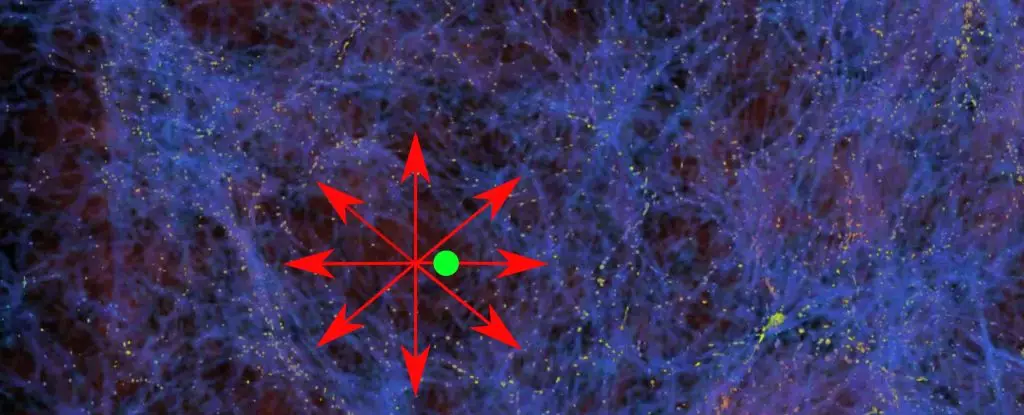As we venture into the boundless expanse of the universe beyond the Milky Way, we are greeted by a tapestry of galaxies scattering the darkness like twinkling stars. It is natural to assume that these galaxies are evenly distributed throughout spacetime. However, upon closer examination, it becomes apparent that galaxies tend to cluster together, forming clusters, filaments, and clumps. These cosmic conglomerations are the result of gravity’s mutual attraction between galaxies, forming matter highways and superhighways across the vast cosmic web. Conversely, we also encounter vast regions of significantly lower density known as voids, which are sparsely populated by galaxies. One such void, situated in the local corner of the Universe, is called the Local Void, and it is where the Milky Way galaxy drifts. Previous studies estimated its size to be approximately 60 megaparsecs or around 200 million light-years. However, this is only a fraction of the whole story. The Local Void might be encompassed by a much larger underdensity known as the Local Hole or Keenan-Barger-Cowie (KBC) supervoid, stretching across an astounding 600 megaparsecs. This remarkable supervoid presents a conundrum as it contradicts the standard model of cosmology, which assumes an even distribution of matter throughout the Universe. Nevertheless, a recent study led by astrophysicist Sergij Mazurenko from the University of Bonn has proposed an intriguing possibility. The Local Hole might hold the key to resolving the Hubble Tension – the discrepancy observed in different measurements of the Universe’s expanding speed. What we need to do now is to deviate from the conventional model and explore alternative avenues.
The rate at which the Universe expands is quantified by the Hubble Constant, symbolized as H0. However, there is no consensus on its precise value due to varying measurement techniques yielding different outcomes. One approach involves analyzing remnants of the early Universe, such as the cosmic microwave background or ancient acoustic waves. This examination yields an expansion rate of approximately 67 kilometers (42 miles) per second per megaparsec. Conversely, astronomers can also measure the distances to more recent celestial objects nearer to us, like Type Ia supernovae or Cepheid variable stars, whose brightness is well-documented. These observations indicate an expansion rate of around 73 kilometers per second per megaparsec. Intriguingly, the measurements suggest that the Universe expands faster in our local vicinity, up to a distance of about three billion light-years, than it does on a universal scale. This peculiar discrepancy is what researchers term the Hubble Tension – a phenomenon that demands an explanation.
The unforeseen solution to the Hubble Tension might emerge from an appreciation of the Local Hole’s impact. As we know, matter exerts gravitational attraction on other matter. Therefore, galaxies moving away from us in our local space could be locally accelerated by the concentrations of matter that surround the edges of the supervoid. This notion parallels a 2020 study suggesting that the Local Void possesses a similar effect but on a much grander scale. Nevertheless, one issue remains, and it pertains to the infamous standard model. According to this model, the Local Hole’s existence poses a significant problem as it deviates from the expected distribution of matter across the Universe. However, this conundrum may be lessened by adopting a different gravitational model known as Modified Newtonian Dynamics (MOND). Proposed four decades ago, MOND offered an alternative explanation to the prevailing dark matter theory, which aimed to reconcile inconsistencies in gravity measurements. Eminent physicist Pavel Kroupa from the University of Bonn suggests that we ought to consider this alternative model to gain fresh insights into our understanding of the Universe. Although MOND has its own set of challenges, it serves as a tool for investigating the gaps in our current understanding. Perhaps the answer lies somewhere in between – an amalgamation of both Einstein’s theories and expansions upon his original ideas.
It is said that Albert Einstein once remarked that we cannot solve problems with the same thinking that led to their inception. In light of this advice, we stand at the threshold of new discoveries, driven by our willingness to question established theories. The mysteries surrounding the Local Hole and the Hubble Tension beckon us to explore unconventional paths and embrace alternative models of gravity. While the standard model provides a solid foundation, it is vital to expand our knowledge by delving into uncharted territories. By doing so, we may unlock a deeper understanding of the mechanics shaping our Universe. As physicists and astronomers continue their tireless quest for truth, we eagerly anticipate the revelations that await us, beyond the confines of traditional thinking.



Leave a Reply